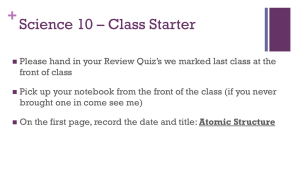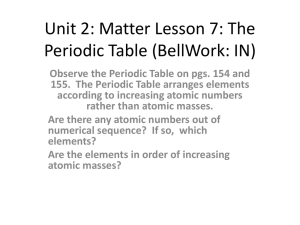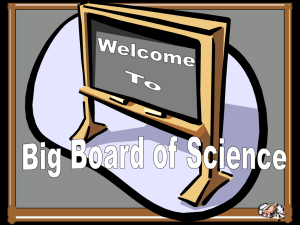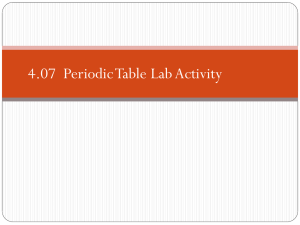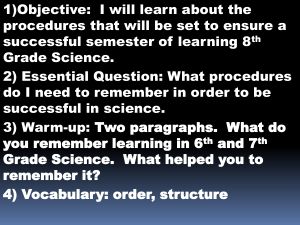C1 - Powerpoint - tonyconnett.com
advertisement
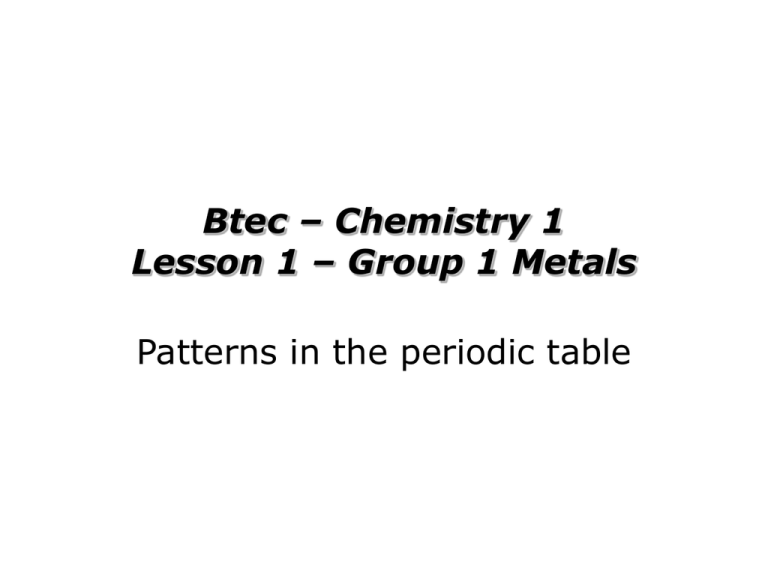
Btec – Chemistry 1 Lesson 1 – Group 1 Metals Patterns in the periodic table Starter Activity • Use the white boards... • In ONE minute name as many chemicals as you can What are we going to learn? Essential... • What the periodic table is • That the position of an element in the periodic table can provide information about its electronic structure Merit grade... • That elements in groups have similar reactions • Be able to predict the reactions of elements in the periodic table Extension / Distinction... • Reactions of elements can depend on their electronic structure The periodic table Task 1 (10 mins)... In groups look at the periodic table, 1. Why is water not in the periodic table? 2. Look at the elements either side of the black zig-zag line – what do you think this line seperates? 3. Is there any pattern in the numbers that are written by each element? One person from each table can use http://www.webelements.com/ to help... Demonstration... (Na, Li, K) Element Appearance Reaction with water Marks out of 10 Na Li K Rb Cs Fr 20 mins We have looked at Li, Na and K Now make predictions for Rb, Cs and Fr Watch DVD and complete table... Patterns in the periodic table Reactivity • Group 1 elements become more reactive as you go down the group • Make an annotation on your worksheet Watch introduction to periodic table and answer questions... Plenary... • In groups – on your white board... 1. What is the periodic table? 2. Draw an outline of the Periodic table, indicate a group and a period 3. What can you say about the reactions of elements in a group? 4. Were there any mistakes in the DVD? Extension... • Use www.webelements.com to find out about the reactions of group 7 elements. • What sort of reactions take place? • Are they similar or different? Not in this lesson... Patterns in the periodic table • It is a bit like gravity • The nucleus of an atom ‘pulls’ and ‘holds’ the electrons in orbit around the nucleus Patterns in the periodic table • The bigger the atom gets, the easier it loses an electron Li K Pattern in the periodic table • So potassium is more reactive than lithium • Francium is the most reactive as it is the largest atom Li K • The nucleus is further away, so the pull is less Pattern in the periodic table • Group 7 elements become less reactive as they go down the group • Why? Pattern in the periodic table • Again it is a bit like gravity • The smaller the atom the easier it gains an electron F Cl Pattern in the periodic table • So Chlorine is less reactive than Fluorine • Astatine is the least reactive in the group as it has the largest atom and the smallest ‘pull’ F Cl Pattern in the periodic table • Group 8 has a full outer shell • It does not want to lose or gain electrons • So they are very un-reactive Ne Ar Boiling points • The boiling points of group 1 decrease down the group • The boiling points of group 7 increase down the group Questions 1. What happens to the boiling point of the metals as you move down group 1 2. Group 1 atoms want to loose an electron, do you think it would be easier to remove an electron from Lithium or Cs? 3. What is the most reactive element in group 1? 4. Group 7 atoms want to gain an electron, which atom would most strongly attract an electron to the ‘gap’ in the outer shell? 5. Which is the most reactive element in group 7? 6. Group 8 elements are unreactive, with reference to their electron structure, why is this? Structure of the Nucleus What have we learnt? We have learnt…… • That the location of an element in the periodic table can provide information about its electronic structure • That elements in groups have similar reactions • Reactions of elements can depend on their electronic structure Structure of the Nucleus… What the numbers mean… • Big number – Atomic Mass Total number of bits in the nucleus • Small number – Atomic Number Number of protons in the nucleus What is the atomic mass? What is the atomic number? • Look at your periodic tables… • What atom is this… (the red ones are protons) Element Atomic number Mass number Number of protons Number of neutrons Number of electrons H 1 1 1 0 1 He 2 4 2 2 2 Li 3 7 C 6 N 6 14 O 7 8 Na 23 Mg 8 11 12 Cl 17 35 Cl 17 37 Cu 29 63 Cu 29 65 12 Isotopes Name Protons 80 35 40 18 35 17 37 17 Br Neutrons electrons Isotopes… • Isotopes are identical in their chemical reactions. • This is because they have the same number of protons and the same number of electrons. • The uncharged neutrons make no difference to chemical properties but do affect physical properties such as melting point and density. Today's wonderful activities… • Complete worksheet (Atomic Structure) • Applied science workbook Questions (p.g. 14-15) • Complete worksheet Assignment Assignment… Scenario…. Produce a magazine article for a forensic science magazine. Make a title page with … • A title (e.g. ‘All about atoms’) • A logo used on the title page and also every other page • ‘South West edition’ or similar to show that it’s a local periodical • Date • Price For the article itself … • text boxes can create columns of text just like a real article in a newspaper or magazine. • Pictures can be hand drawn onto printed sheets or students can cut & stick what they already have • Every page, including the title page must be numbered Grading criteria P1 • Describe atomic and electronic structures of elements 1-20, including isotopes, in the periodic table Grading criteria M1 • Describe the patterns and trends of chemical properties of groups 1 and 7 in the periodic table Grading criteria D1 • Explain the patterns and trends within groups 1 and 7 in the periodic table In more detail… Scenario…. Produce a magazine article for a forensic science magazine. Make a title page with … A title (e.g. ‘All about atoms’) • A logo used on the title page and also every other page • ‘South West edition’ or similar to show that it’s a local periodical • Date • Price P1 • Using diagrams, describe the atomic / electronic structures of the first 20 atoms of the periodic table • State the number of protons, neutrons and electrons for each atom • Define isotopes. Draw and describe the 2 atoms of chlorine, showing the number of protons, neutrons and electrons for each atom M1 • Relate the number of electrons in the outer shells of group 1 and 7 to their group number. Describe how outer electrons are further from the nucleus as we go down the group • Describe patterns and trends in group 1 • Students write a description of the practical to investigate the reactivity of group 7 elements • Describe patterns and trends in group 7 from your results D1 • Explain patterns and trends in group 7 according to their atomic structure Page from Longman FND book 2 that will help… P1 138 M D 1 1 • Using diagrams, describe the atomic / electronic structures of the first 20 atoms of the periodic table 136 • State the number of protons, neutrons and electrons for each atom 137 • Define isotopes. Draw and describe the 2 atoms of chlorine, showing the number of protons, neutrons and electrons for each atom 140 • Relate the number of electrons in the outer shells of group 1 and 7 to their group number. Describe how outer electrons are further from the nucleus as we go down the group 152 • Describe patterns and trends in group 1 153 • Students write a description of the practical to investigate the reactivity of group 7 elements 156 • Describe patterns and trends in group 7 from your results • Explain patterns and trends in group 7 according to their atomic structure Example… • Need a scanned example…



